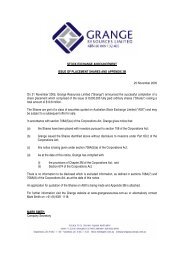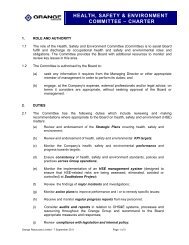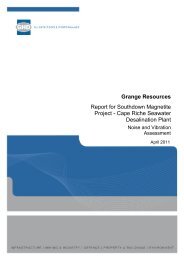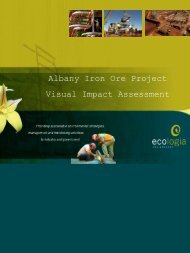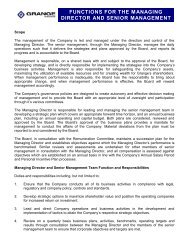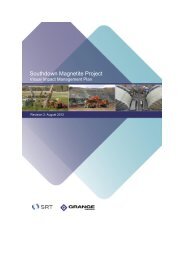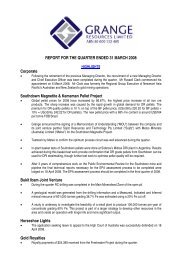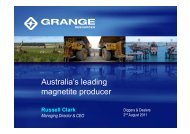2012 Annual Report (2 April 2013) - Grange Resources
2012 Annual Report (2 April 2013) - Grange Resources
2012 Annual Report (2 April 2013) - Grange Resources
Create successful ePaper yourself
Turn your PDF publications into a flip-book with our unique Google optimized e-Paper software.
<strong>2012</strong> ANNUAL REPORT<br />
51<br />
PAGE<br />
The current income tax charge is calculated on the basis of<br />
the tax laws enacted or substantively enacted at the end of<br />
the reporting period in the countries where the company’s<br />
subsidiaries operate and generate taxable income. Management<br />
periodically evaluates positions taken in tax returns with respect<br />
to situations in which applicable tax regulation is subject to<br />
interpretation. It establishes provisions where appropriate on the<br />
basis of amounts expected to be paid to the tax authorities.<br />
Deferred income tax is provided in full, using the liability method,<br />
on temporary differences arising between the tax bases of assets<br />
and liabilities and their carrying amounts in the consolidated<br />
financial statements. However, deferred tax liabilities are not<br />
recognised if they arise from the initial recognition of goodwill.<br />
Deferred income tax is also not accounted for if it arises from<br />
initial recognition of an asset or liability in a transaction other than<br />
a business combination that at the time of the transaction affects<br />
neither accounting nor taxable profit or loss. Deferred income tax<br />
is determined using tax rates (and laws) that have been enacted<br />
or substantially enacted by the end of the reporting period and<br />
are expected to apply when the related deferred income tax asset<br />
is realised or the deferred income tax liability is settled.<br />
Deferred tax assets are recognised for deductible temporary<br />
differences, including MRRT allowances, and unused tax losses<br />
only if it is probable that future taxable amounts will be available to<br />
utilise those temporary differences and losses.<br />
Deferred tax liabilities and assets are not recognised for temporary<br />
differences between the carrying amount and the tax bases of<br />
investments in foreign operations where the company is able to<br />
control the timing of the reversal of the temporary differences and<br />
it is probable that the differences will not revers in the foreseeable<br />
future.<br />
Deferred tax assets and liabilities are offset when there is a<br />
legally enforceable right to offset current tax assets and liabilities<br />
and when the deferred tax balances relate to the same taxation<br />
authority. Current tax assets and tax liabilities are offset where the<br />
entity has a legally enforceable right to offset and intends either to<br />
settle on a net basis, or to realise the asset and settle the liability<br />
simultaneously.<br />
<strong>Grange</strong> <strong>Resources</strong> Limited and its wholly-owned Australian<br />
controlled entities have implemented the tax consolidation<br />
legislation. On 6 January 2011, the Group merged its two<br />
separate tax consolidated group’s and <strong>Grange</strong> <strong>Resources</strong> Limited<br />
became the head entity of the merged tax consolidated group.<br />
As a consequence, <strong>Grange</strong> <strong>Resources</strong> Limited and its<br />
subsidiaries are taxed as a single entity and the deferred tax<br />
assets and liabilities of the Group are set off in the consolidated<br />
financial statements.<br />
(m) Goods and Services Tax (GST)<br />
Revenues, expenses and assets are recognised net of the<br />
amount of GST except:<br />
◆ ◆ when GST incurred on a purchase of goods and services is<br />
not recoverable from the taxation authority, in which case the<br />
GST is recognised as part of the cost of acquisition of the<br />
asset or as part of the expense item as applicable; and<br />
◆ ◆ receivables and payables, which are stated with the amount<br />
of GST included.<br />
The net amount of GST recoverable from, or payable to, the<br />
taxation authority is included as part of receivables or payables in<br />
the balance sheet.<br />
Cash flows are included in the Statement of Cash Flows on a<br />
gross basis and the GST component of cash flows arising from<br />
investing and financing activities, which is recoverable from, or<br />
payable to, the taxation authority, are presented as operating<br />
cash flows.<br />
Commitments and contingencies are presented net of the amount<br />
of GST recoverable from, or payable to, the taxation authority.<br />
(n) Mineral <strong>Resources</strong> Rent Tax (MRRT)<br />
The MRRT was enacted in the reporting period ended 31<br />
December <strong>2012</strong> and commenced on 1 July <strong>2012</strong>. The MRRT<br />
represents an additional tax on profits generated from mining<br />
operations of iron ore and coal miners in Australia<br />
The MRRT is considered, for accounting purposes, to be a tax<br />
based on income and accordingly current and deferred MRRT<br />
expenses will be measured and disclosed on the same basis as<br />
income tax expense as set out in Note 1(l).<br />
(o) Carbon Emissions<br />
Carbon emission units (carbon permits) issued under the Jobs<br />
and Competitiveness Program are recognised as a Government<br />
grant upon receipt and presented as an intangible asset.<br />
Grants from the government are recognised at fair value. The<br />
Government grant is initially recognised as deferred income<br />
and then subsequently recognised in the income statement<br />
systematically over the period based on production from the<br />
emissions intensive activity.<br />
Carbon emission liabilities are recognised as the emissions are<br />
generated and are measured at the present value of the carbon<br />
permits required to extinguish the liability.<br />
Carbon expense and deferred income from carbon permits are<br />
recorded as part of the cost of inventory.<br />
Carbon permit assets and carbon emission liabilities are disclosed<br />
on a gross basis in the consolidated statement of financial<br />
position.



